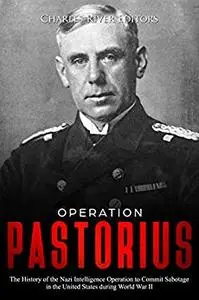Operation Pastorius: The History of the Nazi Intelligence Operation to Commit Sabotage in the United States during World War II by Charles River Editors
English | July 19, 2020 | ISBN: N/A | ASIN: B08DC7BXS3 | 66 pages | Rar (PDF, AZW3) | 3.92 Mb
English | July 19, 2020 | ISBN: N/A | ASIN: B08DC7BXS3 | 66 pages | Rar (PDF, AZW3) | 3.92 Mb
*Includes pictures
*Includes a bibliography for further reading
*Includes a table of contents
World War II stood apart in many ways from every earlier war, not least in the way that it reached to every corner of the planet and involved a noticeable segment of humanity's collective resources. Battles erupted not only on land and the sea's surface as they had for centuries, but also in the ocean depths and the windswept heights of the sky.
One of the war's most crucial struggles happened in the realm of the unseen, inside the human mind and amid the invisible flow of radio waves. Every war is a battle of wits as intelligence-gathering, tactics, and strategies clash, from the level of individual action up to the grand, overarching schemes of generals and statesmen. Intelligence took on a freshly urgent aspect in World War II, however, as the fate of offensives, armies, and nations came to hang on the struggle to decrypt vital enemy radio traffic and military communications.
By the end of 1941, it seemed as if nothing could stop Germany. German forces had swept deep into Russia, killing or capturing hundreds of thousands of prisoners and were closing in on Moscow. In North Africa, German and Italian forces under the command of General Erwin Rommel were poised to take British-controlled Egypt. In the Atlantic, German U-boats were sinking such large numbers of British merchant ships that it seemed as if Britain might be starved into submission.
The Japanese attack on Pearl Harbor presented President Franklin D. Roosevelt with a strategic problem that went beyond how to deal with Japanese aggression. Although the war in Europe had been raging for more than two years, many Americans felt it was not their concern, especially with the ultimate defeat of the British seeming all but certain.
Four days after the attack on Pearl Harbor, Hitler declared war on America, almost casually and without seeming to consider the consequences. There was no diplomatic necessity for him to have done this and no obvious strategic reason. Germany’s military successes were so complete at that point that Hitler seemed to believe declaring war on one more country was a trifling matter.
In some ways, he was right, because in December 1941, the US Army was tiny and poorly equipped. In September 1939, the German army invading Poland comprised 100 infantry divisions and six panzer divisions. At that time, the whole US Army was comprised of just five divisions. Even two years later, the US Army was relatively small and ill-equipped. It was clear that, in strictly military terms, the United States was no threat to Nazi Germany when Hitler declared war in late 1941.
However, American industry had the capacity and power ahead of virtually any other country in the world, so if America posed a threat to Germany, it would be through its capacity to produce weapons, tanks, aircraft, and ships in vast numbers. At the same time, America was simply too far from any German-controlled airbases to make strategic bombing a possibility. Thus, if a direct attack on American industry was not feasible, the best alternative was to mount a campaign of subterfuge and sabotage.
The responsibility for mounting an attack on American industry was given to the German military secret intelligence service, the Abwehr, which devised a plan to land saboteurs in America to attack factories, railroads, and perhaps conduct a random bombing campaign against American civilians. The Nazi plan was given the codename of Operation Pastorius, and it was launched in June 1942, just six months after Germany had declared war on America. What followed was one of World War II’s most bizarre spy stories.
Operation Pastorius: The History of the Nazi Intelligence Operation to Commit Sabotage in the United States during World War II looks at one of the war’s most unique operations.



